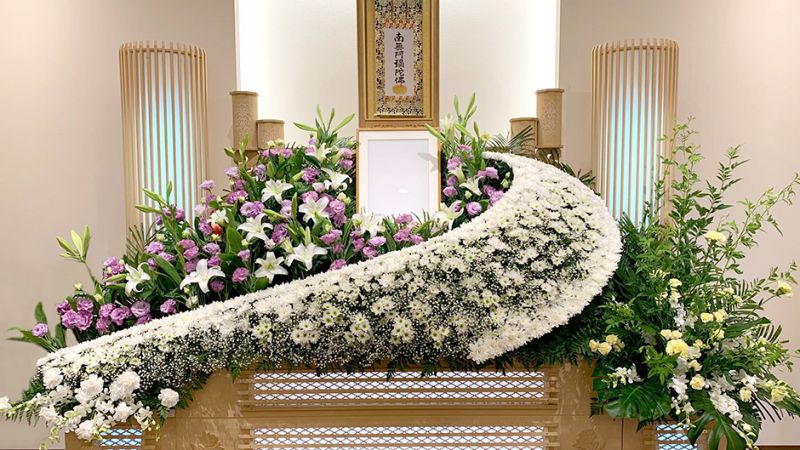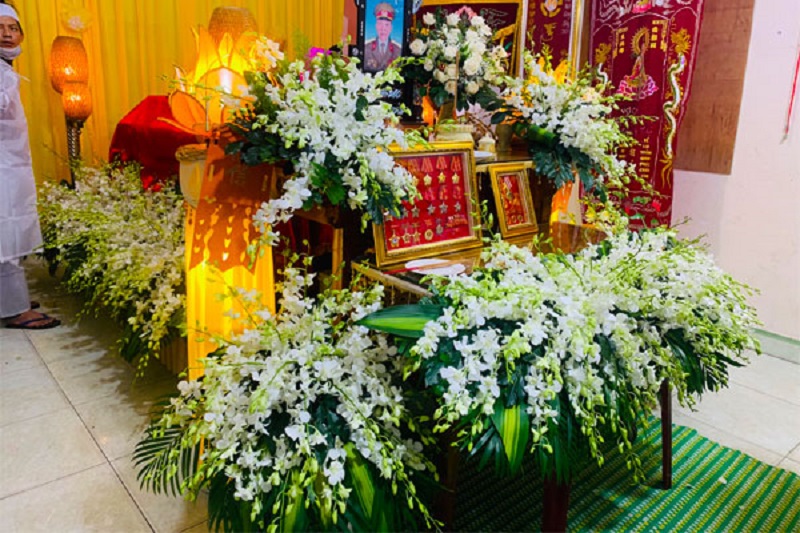Funeral flower arrangements hold a significant place in memorializing the deceased and offering comfort to the bereaved. These arrangements are a timeless way to express sympathy, respect, and condolence. This guide explores the types, design principles, and etiquette of funeral flower arrangements to help you create meaningful tributes.
Types of Funeral Flower Arrangements
Casket Sprays
Casket sprays are placed on top of the casket and come in two variations: full casket sprays, which cover the entire casket, and half casket sprays, suitable for open-casket services. These arrangements typically include a mix of flowers that convey peace and reverence.

Standing Sprays and Wreaths
Standing sprays and wreaths are displayed on easels near the casket or at the entrance of the service. They come in various shapes, such as circular, heart-shaped, and cross-shaped, each carrying its own symbolism of eternity, love, and faith.
Floral Baskets
Floral baskets are versatile arrangements that can be placed around the funeral venue. They are often used to add beauty and serenity to the space and can be sent directly to the bereaved family’s home as a gesture of sympathy.
Sympathy Bouquets and Vase Arrangements
Sympathy bouquets and vase arrangements are suitable for smaller spaces and can be placed on tables or near photos of the deceased. They offer a more personal touch and can be tailored to reflect the preferences of the deceased or the grieving family.
Funeral Posies and Pillows
Funeral posies and pillows are smaller, rounded arrangements placed on the casket or near the service area. They are often used to symbolize eternal rest and are crafted with great care to reflect respect and love.
Choosing Appropriate Flowers
Traditional Flowers
Certain flowers are traditionally associated with funerals due to their meanings. Lilies symbolize the restored innocence of the soul, roses represent love and respect, and chrysanthemums are commonly used in funeral arrangements to denote honor and sympathy.
Color Significance
The color of flowers in funeral arrangements carries deep significance. White flowers represent purity and peace, red symbolizes love and strength, and yellow can signify friendship and celebration of life.
Cultural and Religious Considerations
Different cultures and religions have unique customs regarding funeral flowers. It’s essential to be mindful of these traditions to ensure that the arrangements are appropriate and respectful.
Design Principles for Funeral Flower Arrangements
Symmetry and Balance
Creating harmonious and visually balanced arrangements is crucial. Symmetry brings a sense of order and peace, which is comforting during a time of loss.
Proportion and Scale
The size of the arrangement should match the setting and the casket. Overly large or small arrangements can feel out of place, so proportionality is key.
Color Coordination
A soothing and respectful color palette helps convey the right emotions. Soft, muted colors are often preferred to create a calm and reflective atmosphere.
Texture and Foliage
Incorporating different textures and greenery adds depth and interest to the arrangement, making it more visually appealing and dynamic.

Steps to Create a Funeral Flower Arrangement
Selecting Flowers and Foliage
Choose flowers and greenery that convey the appropriate sentiments. Consider the deceased’s favorite flowers or colors if you know them.
Preparing the Flowers
Trim the stems, remove thorns and excess leaves, and ensure the flowers are hydrated and fresh.
Arranging the Flowers
Start with the largest flowers and work your way down to smaller ones, filling in gaps with foliage. Ensure each flower has its own space to stand out.
Final Touches
Add ribbons, cards, or personal touches like small mementos that reflect the deceased’s personality or interests.
Personalizing Funeral Flower Arrangements
Incorporating Personal Elements
Adding items that reflect the deceased’s hobbies, passions, or personality can make the arrangement more meaningful and personal.
Custom Messages
Attach personalized messages or ribbons with inscriptions to express your heartfelt sentiments and condolences.
Delivering and Displaying Funeral Flowers
Coordination with Funeral Home or Venue
Ensure timely delivery and proper placement by coordinating with the funeral home or venue. This ensures that the flowers are displayed as intended.
Placement of Arrangements
Different types of arrangements have designated places during the service. Casket sprays go on the casket, standing sprays near the service area, and floral baskets can be placed around the venue.
Etiquette and Considerations
Sending Funeral Flowers
It’s appropriate to send flowers to the funeral home, service, or directly to the bereaved family’s home. Be mindful of timing to ensure the flowers arrive when they can be most appreciated.
Attending the Funeral
When attending the funeral, follow proper etiquette by respecting the family’s wishes regarding flowers and where they should be placed.
Sympathy Messages
Writing appropriate and heartfelt messages to accompany the flowers is crucial. Express your condolences, share a memory, or offer words of comfort.
Conclusion
Funeral flower arrangements are a beautiful and respectful way to honor the deceased and provide solace to those grieving. By understanding the different types, principles, and etiquette of funeral flower arrangements, you can create meaningful tributes that convey your deepest sympathies and respect.
